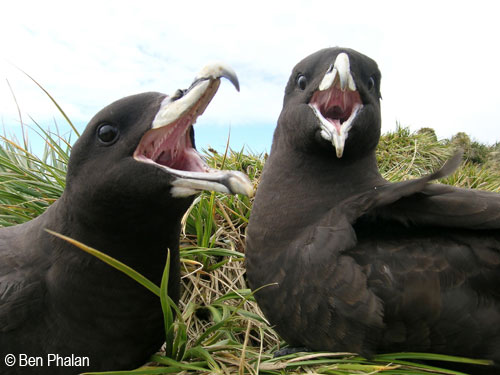Claudia Mischler (Wildlife Management International Limited) and colleagues have published in the New Zealand journal Notornis on variation in bycaught White-chinned Petrels Procellaria aequinoctialis in New Zealand waters.
The paper’s abstract follows:
“Discriminant function analysis (DFA) was used to determine gender and geographic variation in the morphometrics of white-chinned petrels (Procellaria aequinoctialis) measured from fisheries bycatch in New Zealand. Samples were divided into 5 clusters based on capture location. A DFA model was created using adult breeding birds presumed to be from the 2 main locations at the Auckland Islands and Antipodes Islands. Geographic variation in head and bill, skull width, culmen, culmen depth at base, culmen width at base, right and left mid-toe and claw, tail, and right and left wing was found between birds presumed to be from the ‘Auckland’ and ‘Antipodes’ clusters, with ‘Antipodes’ birds being generally larger than ‘Auckland’ birds. Gender variation in head and bill, skull width, culmen, culmen depth at base, culmen width at base, minimum bill depth, right and left mid-toe and claw, right wing, right and left tarsus existed for ‘Auckland’ birds. Gender variation in head and bill, skull width, culmen, culmen depth at base, culmen width at base, minimum bill depth, right and left mid-toe and claw, and tail existed for ‘Antipodes’ birds. Birds in the other 3 clusters were classified as originating from the Auckland Islands or Antipodes Islands. The clustering suggested that birds from the Auckland Islands tended to forage mostly north and west, whereas birds from the Antipodes Islands foraged mostly towards the north. There were large overlaps at Puysegur Point and particularly the Chatham Rise of birds from both breeding locations. This study shows the usefulness of bycatch necropsies, and emphasises the need for further studies in geographic variation and sexual dimorphism at all New Zealand breeding locations.”

White-chinned Petrels, photograph by Ben Phalan
Reference:
Mischler, C.P., Robertson, C.J.R. & Bell, E.A. 2015. Gender and geographic variation in morphometrics of white-chinned petrels (Procellaria aequinoctialis) in New Zealand and their foraging activities as determined from fisheries bycatch. Notornis 62: 63-70.
John Cooper, ACAP Information Officer, 05 August 2015

 English
English  Français
Français  Español
Español